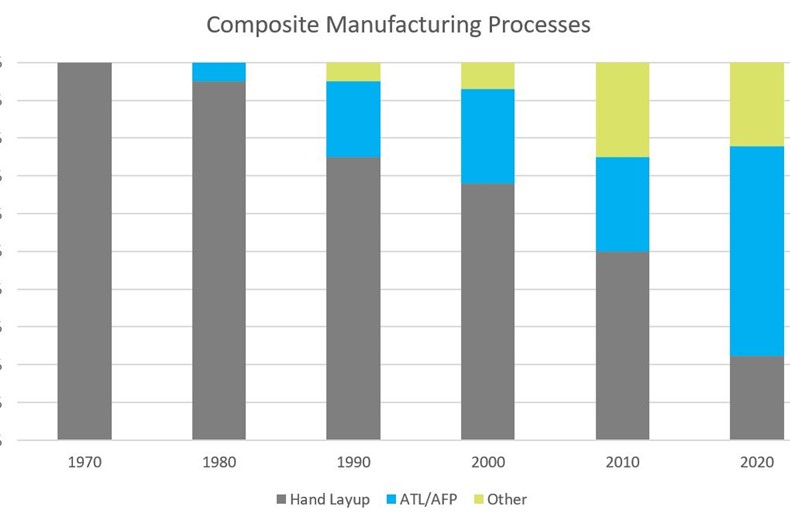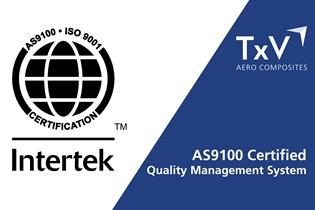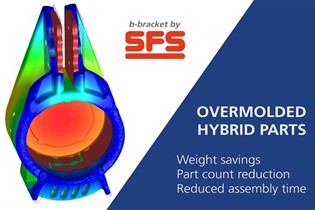The Maturation of Composite Manufacturing in Aerospace
August 13, 2019

Jonathan Sourkes, Senior Account Manager, TxV Aero Composites
Composites have been routinely used in the manufacture of aircraft since the seventies. In the early days, all of this manufacturing was done by hand. This has fallen steadily over the years and decades with the introduction of automation and recent technology advancements.
Inversely, automated composites manufacturing, which was introduced to the aircraft industry in the eighties has steadily grown and is projected to account for approximately 50% of composites manufactured for aircraft applications. In this automation category, there are two primary manufacturing technologies: Automated Tape Laying (ATL) and Automated Fiber Placement (AFP).
Is Automated Production the Future of Composites in Aerospace?
The trend toward automation in aerospace composites follows countless Post-Industrial Age examples and for obvious reason: as technology matures there is a shift from innovation – i.e. what does this new technology enable us to accomplish? to efficiency – i.e. how can we maximize our return from this technology?
In the aerospace industry, the light-weighting and mechanical benefits of composite technology are widely accepted, as demonstrated by their steady growth in the manufacture of aircraft since their introduction. Projecting ahead, composites have more to offer the industry with respect to system cost reduction and increased throughput, especially with regards to thermoplastic unidirectional tapes (TPUDT), which are well suited for automated composite manufacturing processes. Both AFP and ATL hold significant potential to address current industry challenges. Significantly, although AFP and ATL can also be used to process thermoset unidirectional tapes, these materials require autoclave curing whereas thermoplastic composites are already polymerized and therefore can be processed without the lengthy autoclave cure. Thermoplastics have a number of additional benefits compared to thermoset: unlimited shelf-life; no need for refrigeration; and recyclability. However, in terms of maximizing throughput, out of autoclave production is a significant distinction.
The aircraft industry is facing a throughput challenge. Emerging market demands for new aircraft have caused OEMs to seek out solutions to satisfy an ever-growing build rate; a challenge that automation will address. It takes no stretch of the imagination to see how automated production will yield faster production rates. However, perhaps more important than the achievement of rate is that automation also leads to more predictable and repeatable serial production of high-quality components. With the advancements in hardware and software realized over the past 30+ years and the enhancements in available material technologies, there is a convergence to support the production of high-quality aerospace composite parts in commercial quantities.
Making the Switch from Hand-laid to Automated Composite Manufacturing
These automated production methods are not without challenges. Manual processing has been the dominant production method since composites were introduced to the aerospace industry. Switching to an automated process may be considered a natural evolution, but it takes time to validate processes and inspection techniques and for them to be documented in specifications. Additionally, production utilizing TPUDT requires new material allowables and specifications. Design engineers must also be educated on how these materials can be utilized in applications and how to design parts to take advantage of new processing equipment and manufacturing techniques. Simply put, the infrastructure needed to address the challenges does not exist today, at least not completely. That being said, the industry is not yet able to hit rate, so the question becomes: do we invest in mature materials and technology likely at the end of its lifecycle, or cross the chasm into new materials and processes that hold the promise for future efficiencies? If OEM investment is an indication, I suspect the latter.
The industry needs guidance on how to slot TPUD parts in with thermoset composite and metal alloy-based parts.
We at TxV firmly believe collaboration is the key. Our 50,000 sq ft facility was built with the sole purpose of manufacturing aerospace quality parts at the volumes required by commercial aerospace. Imagine if you had 30+ years of continuous improvement experience and an intimate knowledge on how to processes PAEK composites. Armed with this knowledge and a blank canvas, you then built an optimized manufacturing facility from the ground up. This is TxV, a combination of material and manufacturing expertise with one singular focus – to deliver composite parts and assemblies for commercial aerospace applications.
TxV works as an extension of your design and engineering team to create composite solutions that meet your performance needs at lower weight and system cost. Partner with TxV and start your project today!
*Data available upon request.
You might also like

